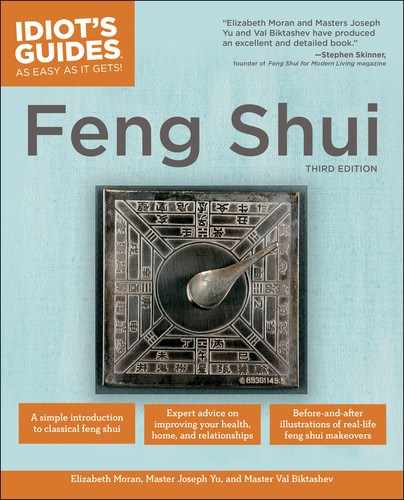Chapter 6
The Principle of the Five Phases
In This Chapter
![]() Understanding the five phases of fire, earth, metal, water, and wood
Understanding the five phases of fire, earth, metal, water, and wood
![]() Learning the cycles of the five phases
Learning the cycles of the five phases
![]() Balancing qi using the five phases
Balancing qi using the five phases
![]() Five phase remedies
Five phase remedies
![]() Mirrors and feng shui
Mirrors and feng shui
With keen interest the ancients watched, monitored, compared, and contrasted that which occurred in nature to that which was made manifest in our bodies and in our lives. Over time, an accumulation of knowledge and experience produced the principle of the five phases. Based on an acceptance of how the world operated, the principle offered a predictable and systematic solution to how qi moves through the cyclic changes of yin and yang.
In feng shui, the interaction of the five phases is used extensively to enhance positive qi and correct negative qi. Understanding its cycles is what this chapter’s all about. The principle of the five phases is the backbone of feng shui. Also, you’ll need a solid understanding of the phase relationships in order to make sense of the one method of classical feng shui that we present in this book—Flying Star, as well as a method of Chinese astrology called The Four Pillars of Destiny—something you’ll learn about in Parts 4 and 6, respectively.
What Are the Five Phases?
Like yin and yang, the five phases are five characteristics or types of qi that change over time. For example, ice, snow, steam, and fog represent types of water that transform over time. Similarly, the five phases are five physical elements in nature—fire, earth, metal, water, and wood—that represent different manifestations of qi. The operative word here is phases. The movement, transformation, and interaction of each phase are what is studied, not the particular element itself. Remember, a tree, a rock, and a human being are actually bundles of intertwining energy—phases interacting. From creation and birth to maturity and decay, everything revolves around the changes of yin and yang.
The ancient Chinese believed that the interaction of the five phases creates all that exists on the heaven, earth, and human planes. Each phase has its own qi character and, thus, interacts with other phases in different ways. Fire qi radiates; earth qi compacts; metal qi contracts; water qi falls; and wood qi grows upward. How the five phases interact with one another determines the balance of qi in nature, in our living/working space, and in our beings.
Wise Words
The five phases of fire, earth, metal, water, and wood represent characteristics of qi that change over time.
If It’s Fire, It Must Be Summer
Each phase element is associated with a season, direction(s), weather condition, color(s), number(s), and a trigram (the subject of the next chapter). Referring to the following table, you may question why earth can have three direction values, or how numbers correspond to each element. This is because the five phases, the eight trigrams, and the Luoshu, or magic square, which we’ll tell you about in Chapter 11, have been correlated into a nice, neat package.
What does this mean? In the early Warring States period (475–221 B.C.E.), the principles of the five phases, the eight trigrams, and the nine numbers of the Luoshu magic square all existed separately. By the time of the Han dynasty (206 B.C.E.–220 C.E.), the principles combined, correlating into an integrated whole.
Master Class
In Chinese, the five phases are known as wuxing or technically, wu zhong liu xing zhi qi, meaning “the five kinds of qi prevailing at different times.” With earth positioned in the center, fire qi (south) dominates in summer, metal qi (west) in autumn, water qi (north) in winter, and wood qi (east) in spring. The earliest documentation of five-phase theory (wuxing) can be found in the Duke Zhao section of Zuo Qiuming’s work, the Zuozhuan (541 B.C.E.).
First, the five phases were correlated to the four cardinal directions. With the phase earth placed in the center, fire-metal-water-wood readily connected to south-west-north-east. Then, this diagram was correlated to the eight directions, eight trigrams, and nine numbers of the Luoshu. Of course, correlating four- and five-term systems to eight- and nine-term systems posed problems. To solve the matter, the Chinese arbitrarily assigned phases to the four corner directions/Luoshu numbers. All of this may seem confusing. To better grasp what we’ve described, take a look at the illustration of the nine-celled grid (called the bagua) in Chapter 7.
But wait! The preceding table shows five seasons. This is to accommodate the phase earth (remember, initially, earth was placed in the center of the four cardinal directions and corresponding phases). Among other associations, earth now corresponds to late summer, the northeast, southwest, and the center cell of the bagua (a term you’ll become familiar with in the next chapter).
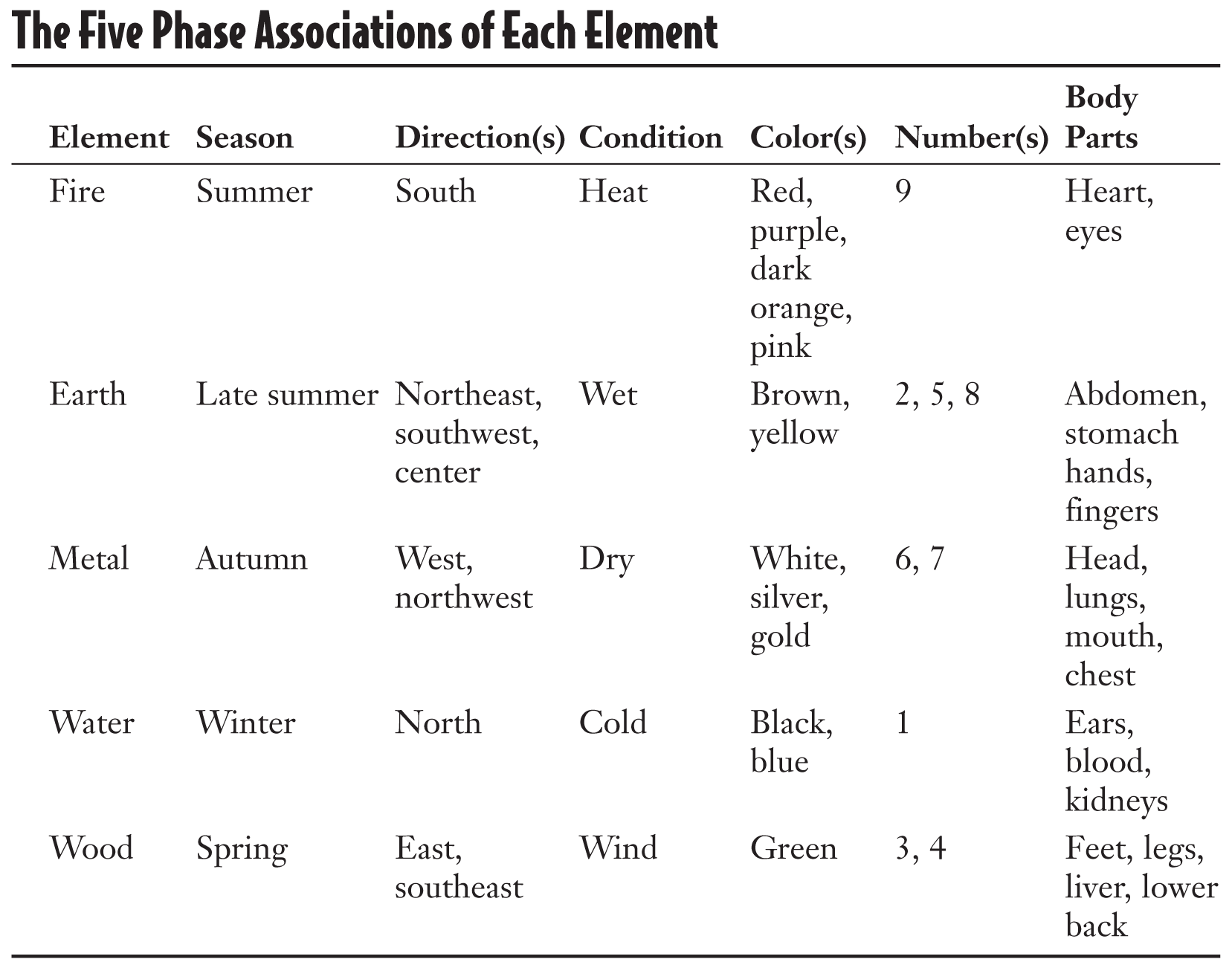
Feng Facts
In humans, the five phases correspond to our vital organs, senses, body characteristics, and emotions. For example, fire is associated with the heart/small intestines and joy; earth with the spleen/stomach and intense concentration; metal with the lungs/large intestines and grief; water with the kidney/urinary/bladder and fear; wood with the liver/gallbladder and anger. Considering these relationships, it’s not surprising that an overly sad person taxes his lungs to cry and sigh, that intense fear may cause a release of the bladder, or that excessive joy could produce heart ailments. Recently, a friend of ours was playing the slot machines. She won the $5,000 jackpot, but her jubilation triggered a heart attack. Practitioners of acupuncture, acupressure, and herbs use the five phases concept to correct imbalances of qi in our bodies.
The Productive Cycle
The productive cycle, shown in the following figure, is one of balance and creation. Each phase produces, or enhances, the succeeding phase. This progressively producing relationship of the five phases is known as the “mother-son” relationship. Each phase is the “son” of the phase that produces it, and the “mother” of the one it produces.

As you can see, each phase follows a natural progression, the sequence of change creating harmony and balance. On paper, this seems logical. It makes sense. Yet, we react much differently when confronted with, say, an out-of-control brush fire threatening to consume our home. We must understand that actually, things are in control. Rainfall produces lush greenery that dries, causing raging fires. End of story. Think about this the next time you’re tempted to buy that mountain retreat or beachfront cottage!
The Controlling Cycle
The controlling cycle, shown in the following figure, is just that. Each phase controls its counterpart. It’s a cycle of imbalance. The controlling cycle sets into motion weakened and depleted qi, which stagnates the environment and causes illness and other unwanted effects in us.
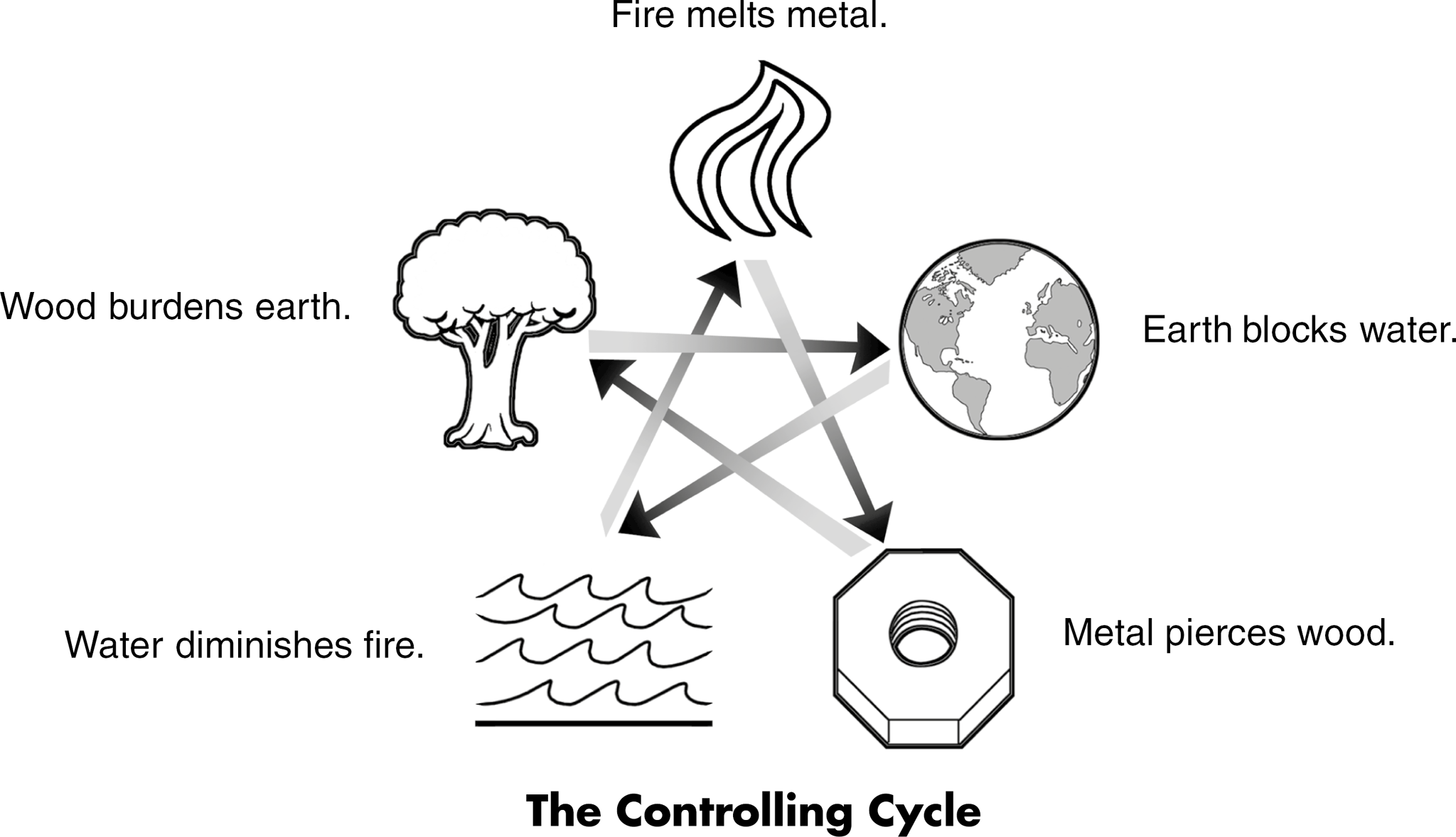
The controlling cycle describes a battle between confronting qi. On the positive side, qi’s counterpart keeps it under control, in check. On the negative side, qi’s counterpart suggests unceasing conflict. In the controlling cycle, the phases control or dominate each other. Harmony and order give way to discord and chaos.
The Weakening Cycle
The weakening cycle, shown in the following figure, reduces the power of the controlling phase and restores the sequential balance (the productive cycle) of the phases in question. In feng shui, more often than not, the weakening cycle is used to remedy negative, or controlling, qi. The weakening cycle combines the productive and controlling cycles and is represented by the dotted lines revolving in a counterclockwise motion.
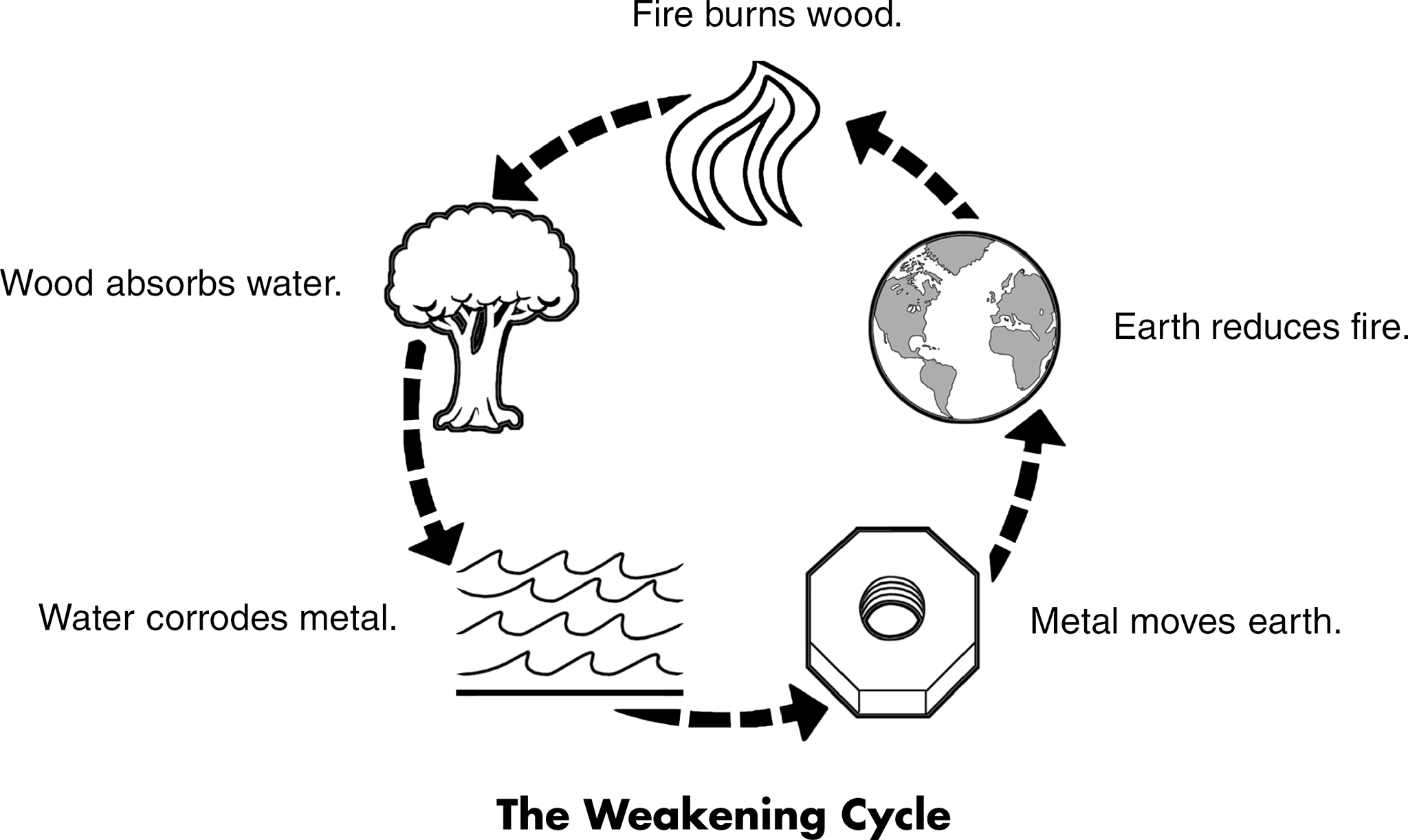
But, you may ask, how does a reductive phase remedy controlling qi? Good question. Let’s look at a few examples. If water controls fire, how would you propose to lessen water’s power? Would you add earth, metal, or wood? If you answered earth, guess again. Earth would certainly dominate (controlling cycle) water’s power, but it will also reduce (reductive cycle) fire. Earth then would become too dominant over water and fire. If you believe metal will reduce water’s control, this, too, is an incorrect assumption. Metal produces (productive cycle) water. You would be adding to water’s power. The correct answer is wood. Wood both absorbs (reductive cycle) water’s power and fuels (productive cycle) the weakened fire. By adding wood, the natural sequence of qi is restored.
Feng Alert
Many have mistakenly called the controlling cycle “the destruction cycle.” Remember, energy cannot be destroyed, it can only change form.
Here’s another example. In this situation, let’s make earth the controlling agent over water. How would you propose lessening earth’s power? Would you add wood or metal? If you answered wood, guess again. Wood diminishes earth and reduces water. It would dominate over two weakened agents—earth and water. If you answered metal, you’re getting it! Metal both reduces earth and produces water. For example, if a mudslide dams the little creek in your backyard, you would use a shovel (metal) to clear the earth, allowing the water to flow. Right? If this mudslide blocked a river, you would use a bulldozer (a really big piece of metal). Get the idea?
Master Class
The weakening cycle provides a means to remedy controlling qi.
Generally, if the relationship is productive, a remedy is not needed. If one phase controls another phase, the reductive phase is used to revert the cycle to a productive one. Remember, the weakening cycle creates balance, restoring the productive sequence of qi without creating any side effects. Metal’s contractive qi force and wood’s expansive qi are balanced with water’s downward pull. Fire’s rising qi and metal’s contractive qi are balanced with earth’s compacting force, and so forth.
Although these rules are generalities, please understand there are exceptions that you’ll find out about in Part 4. The exceptions have to do with the Luoshu number with which each phase is affiliated. The inherent characteristic of the number, its timeliness, the numbers it is combined with, its correlative effect on our well-being, and the position of the number in the combination are layers of information that must be studied in order to apply the appropriate five-phase remedy. For example, take a 4 (wood) 5 (earth) combination. It is a controlling combination known to bring financial loss and breast tumors. Although you might think to add fire to restore a productive balance (wood-fire-earth), this isn’t the proper remedy here. As you will come to learn, the number 5 earth (and 2 earth) are inherently sinister numbers that must be directly dealt with. Moreover, the number 5 (and 2) are dead, making them even more harmful. In this case, the remedy is to add metal. Metal reduces the number 5 earth that will greatly lessen the probability for misfortune.
Here’s another example. Take a 1 (water) 8 (earth) combination. You’re correct if you’ve determined that it’s a controlling combination (earth blocks water). Although adding metal would certainly restore order (earth-metal-water), at this early stage in the book, you have not yet learned that the number 8 is the king money number for 20 years beginning in 2004. In this case, with the number 8 properly positioned on the right or money side, water is needed to enhance good fortune.
So you see, classical feng shui is not a black and white, one-size-fits-all scheme. This is why it is impossible to provide you with a chart outlining a remedy based solely on the relationships between each phase. Moreover, you must consider other numbers like the time and annual numbers. Again, you’ll learn how to analyze number combinations in Parts 4 and 5.
A Spoonful of Sugar
In feng shui, recognizing the correct remedy and selecting the proper remedying agent are key to promoting balance in your home. With balance comes better health, wealth, and relationships.
In our experience, using the actual phase is more effective than using the phase’s corresponding color. For example, if a particular area in your home calls for water, a table fountain is much more effective than painting the walls blue. However, sometimes it isn’t always possible to use the actual phase. For example, leaving a candle burning or a fire blazing in the fireplace is negligent if left unattended. When using color, it’s important that items such as walls, upholstery, carpets, bedspreads, and drapes be of the same color for maximum benefit to your well-being. Following are suggested remedies for each of the five phases.
Master Class
The vibration of the remedy’s qi must be strong enough to balance the controlling agent. Therefore, the size of the remedy must be proportional to the size of the room. You must feel its essence.
Fire remedies include …
![]() A burning candle or working fireplace.
A burning candle or working fireplace.
![]() Lamps with red shades or red light bulbs burning 24 hours.
Lamps with red shades or red light bulbs burning 24 hours.
![]() The colors red, purple, dark orange, and pink.
The colors red, purple, dark orange, and pink.
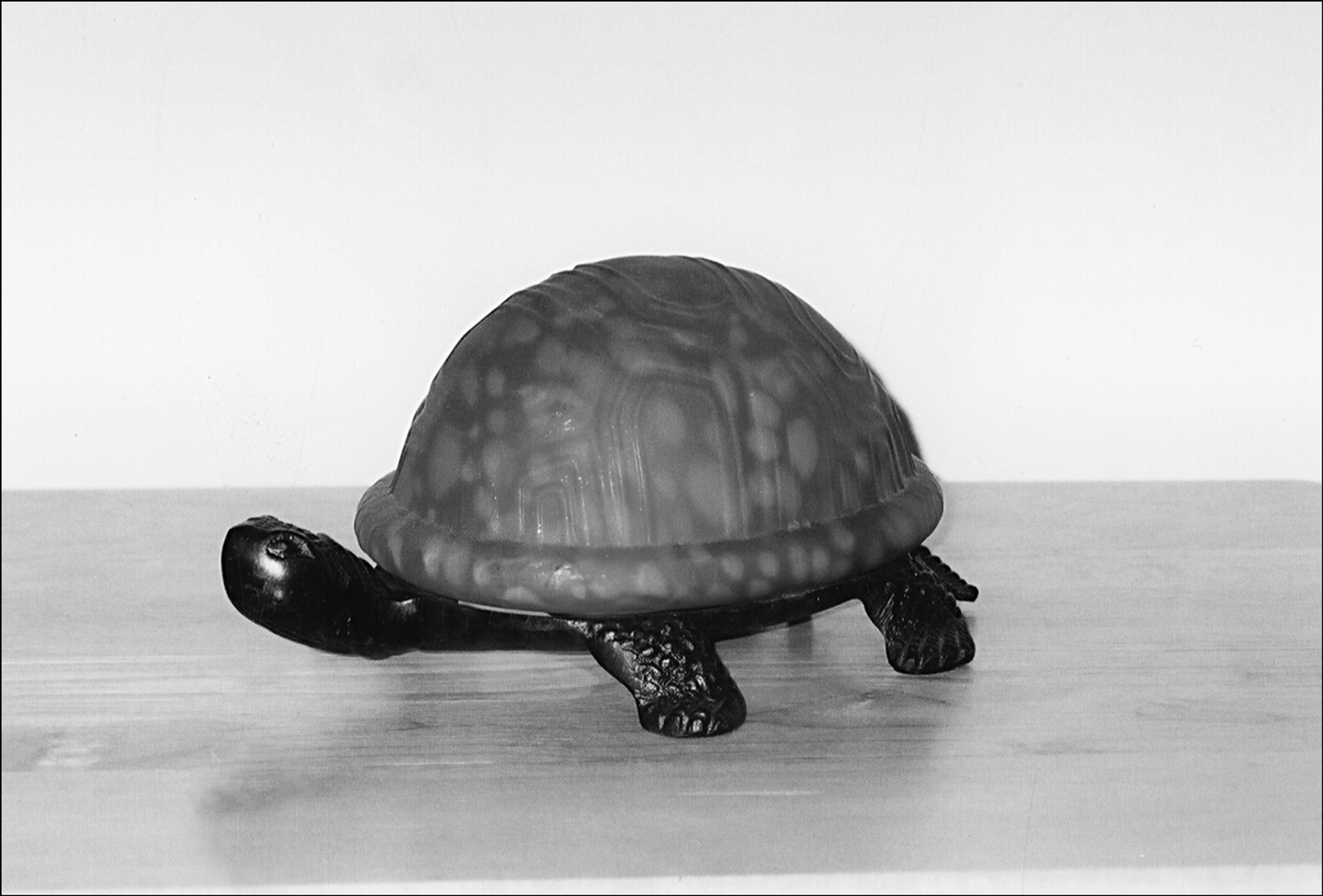
(Photograph by Val Biktashev)
Feng Alert
You cannot mix phase elements. In other words, if the water phase is needed in a particular area, make sure that other phase elements don’t conflict with the remedy. In this case, the room mustn’t be a red tone (fire). Avoid placing plants (wood) here. An abundance of earthenware may also upset the balance. Although metal produces water, make sure that metal objects don’t overwhelm water’s essence.
Earth remedies include …
![]() Rocks.
Rocks.
![]() Ceramic, clay, or cement figurines, sculptures, table bases, or lamps.
Ceramic, clay, or cement figurines, sculptures, table bases, or lamps.
![]() The colors brown and yellow.
The colors brown and yellow.

(Photograph by Val Biktashev)
Metal remedies include …
![]() Brass, steel, silver, gold, copper, or bronze figurines, picture frames, bed frames, planters, exercise equipment, chiming and/or pendulum clocks, filing cabinets, lamps, or fixtures.
Brass, steel, silver, gold, copper, or bronze figurines, picture frames, bed frames, planters, exercise equipment, chiming and/or pendulum clocks, filing cabinets, lamps, or fixtures.
![]() The colors white, gold, and silver.
The colors white, gold, and silver.
![]() The metallic sound of wind chimes, a chiming clock, or piano playing.
The metallic sound of wind chimes, a chiming clock, or piano playing.

(Photograph by Val Biktashev)
Water remedies include …
![]() Aquariums, table fountains, a container of clean moving water, or humidifiers. Note: Although fish are aesthetically pleasing, they aren’t necessary. A waterbed is not a water remedy, because the water is concealed.
Aquariums, table fountains, a container of clean moving water, or humidifiers. Note: Although fish are aesthetically pleasing, they aren’t necessary. A waterbed is not a water remedy, because the water is concealed.
![]() The colors black and blue.
The colors black and blue.

(Photograph by Val Biktashev)
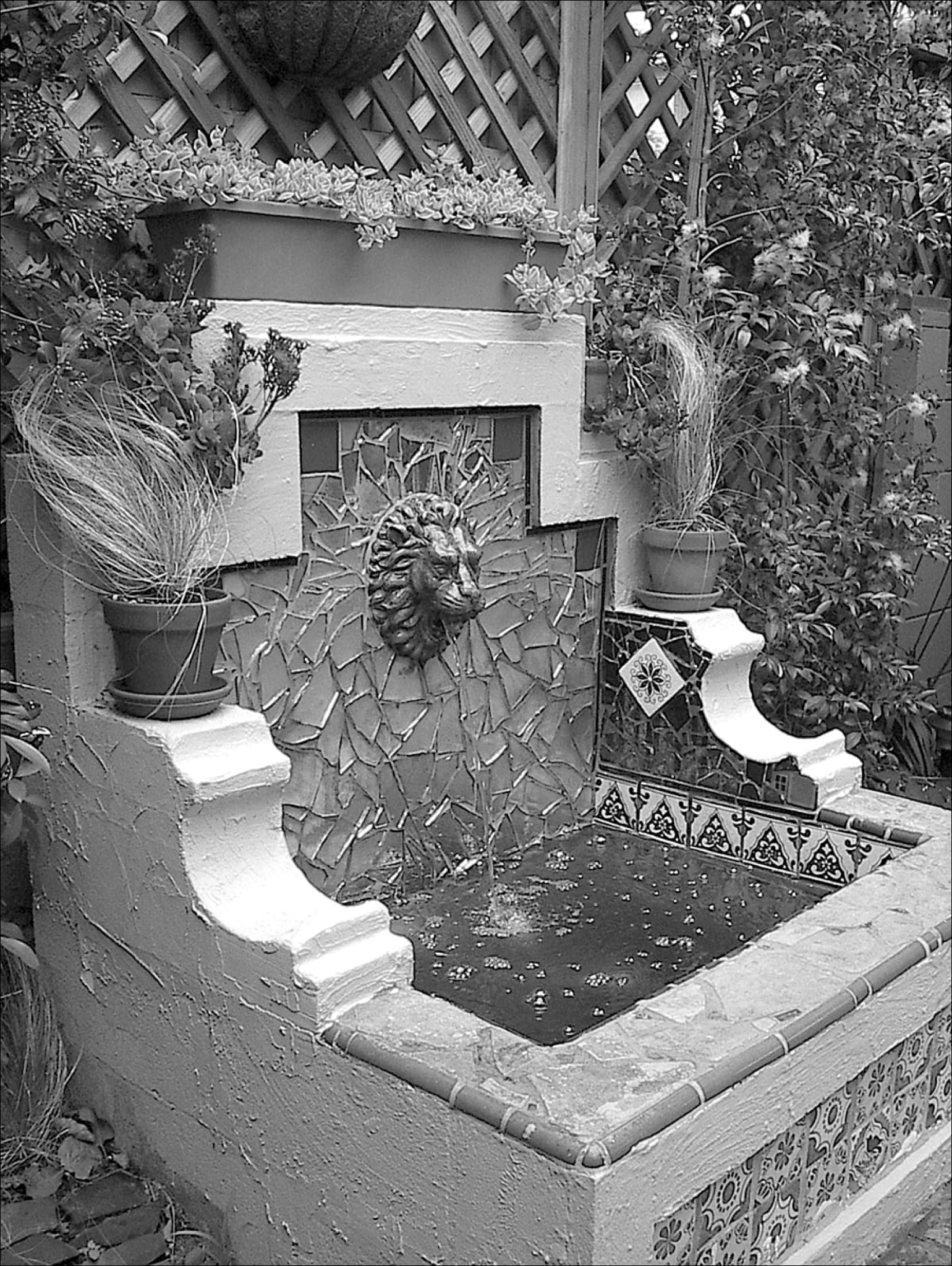
(Photograph by Val Biktashev)
Wood remedies include …
![]() A living plant or tree.
A living plant or tree.
![]() The color green.
The color green.
Note: Dead wood such as hardwood floors and furniture cannot be used as a remedy. Dried flower arrangements or wreaths also do not count as a remedy.
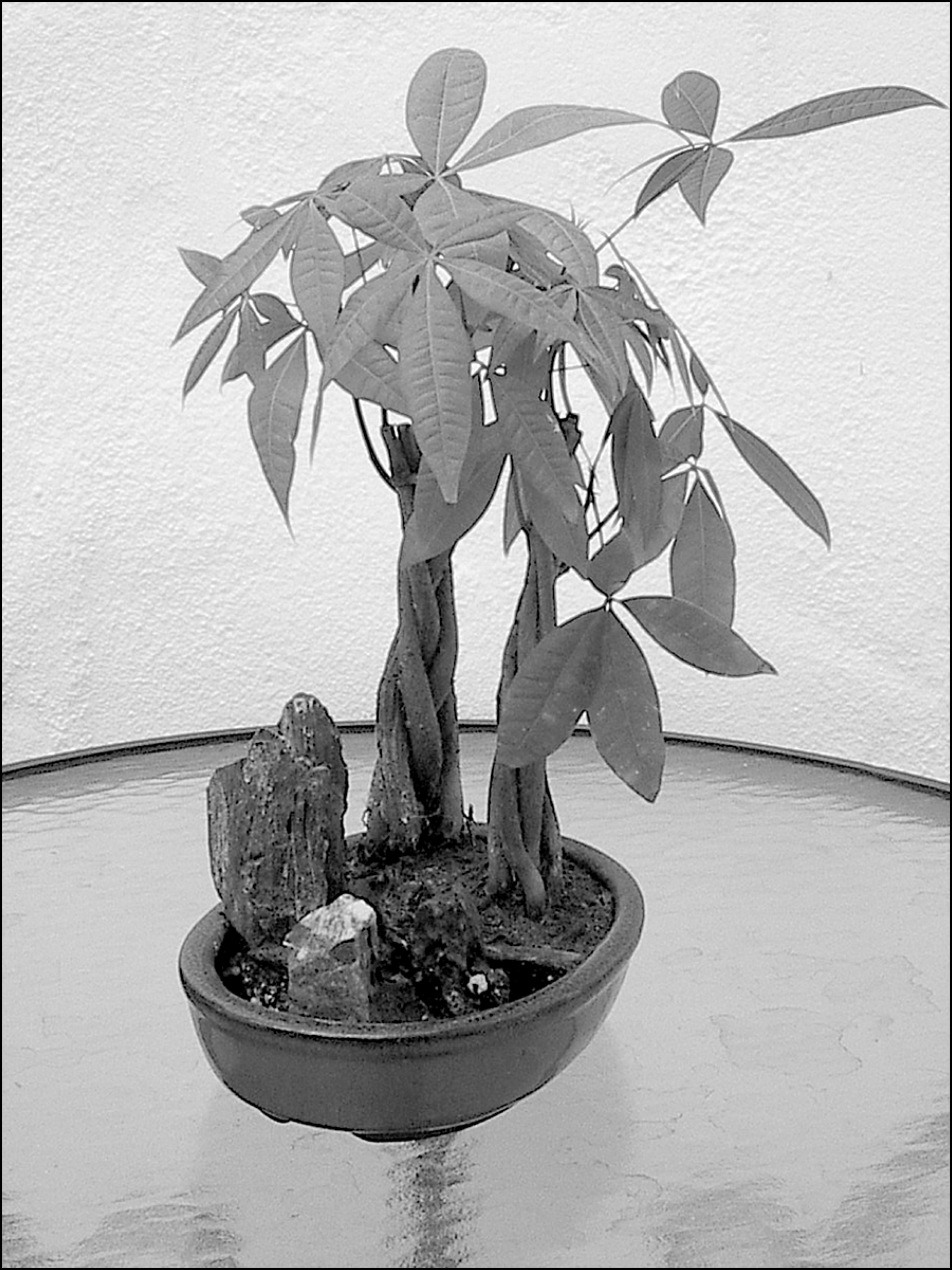
(Photograph by Val Biktashev)
Mirror, Mirror …
Mirrors have never been used as a remedy in classical feng shui. The belief that mirrors can ward off evil omens, absorb, deflect, or stimulate qi’s movement is wishful thinking. Mirrors only reflect light hitting its glass surface. So, where does the misconception about mirrors come from? The precursor to the modern Loupan compass was called a shi pan. Made of a round “heaven” disc that swivels on a square “earth” base plate, the shi pan was inscribed with various images of the cosmos, including an image of the Big Dipper (Beidou). Interestingly, the inscribed Dipper is a mirror opposite from its true configuration in the heavens. This is because the shi pan “mirrors” the perfect and ideal world. In the Han dynasty (206 B.C.E.– 220 C.E.), mirrors were made of polished bronze, also illustrating the model world. Both the bronze mirrors and shi pan were considered magical because they reflected an absolute balance between heaven and earth. They were even buried in tombs to help the deceased into the next world.
The Five Phases of Buildings
Building shapes correspond to the five phases, too. Triangular buildings are associated with fire qi. Many churches conform to this shape. So does your local International House of Pancakes! Square and rectangular buildings represent earth qi. Most of our homes are square, allowing qi to meander and spiral from room to room. Round or domed-shaped buildings represent metal qi. Sports arenas, coliseums, and observatories conform to this shape. New York’s Guggenheim Museum is an excellent example. Round on the outside, its inner art galleries are spirally arrayed, inviting onlookers to be swallowed along a circular path. Wavy shapes correspond to water qi. Structures with variegated roof/ceiling lines conform to this shape. Finally, tall buildings, like skyscrapers, correspond to wood qi’s growth and expansion.
Is one shape better than the other? Do certain shapes promote a healthy well-being while others inspire illness and misfortune? These questions and more will be addressed in Chapter 10.
The Five Phases Quiz
You know this stuff must be important if there’s a pop quiz! If you’re going to practice feng shui, understanding the five phases is just as important as learning how to tie your shoelaces and drive a car. Give it a try.
1. Stated in this order, fire, wood, water, metal, and earth represent what cycle?
a. The productive cycle
b. The controlling cycle
c. The weakening cycle
2. Fire controls ______________.
Earth controls ______________.
Metal controls ______________.
Water controls ______________.
Wood controls ______________.
3. The color white, autumn, and west are associated with which phase?
a. Fire
b. Earth
c. Metal
d. Water
e. Wood
4. Which phase acts as the weakening agent for fire’s control over metal?
a. Fire
b. Earth
c. Metal
d. Water
e. Wood
5. Fire produces ______________.
Earth produces ______________.
Metal produces ______________.
Water produces ______________.
Wood produces ______________.
6. Wooden furniture can be used as a wood remedy.
a. True
b. False
7. Wood acts as a weakening agent for which controlling relationship?
a. Fire-metal
b. Metal-wood
c. Water-fire
8. The color black, north, and winter are associated with which phase?
a. Fire
b. Earth
c. Metal
d. Water
e. Wood
9. You must have fish in your aquarium for the water remedy to work.
a. True
b. False
10. The five phases provide the only remedies to correct negative qi.
a. True
b. False
Answers: 1. c; 2. Fire controls metal; earth controls water; metal controls wood; water controls fire; wood controls earth; 3. c; 4. b; 5. Fire produces earth; earth produces metal; metal produces water; water produces wood; wood produces fire; 6. b; 7. c; 8. d; 9. b; 10. a.
So, how did you do? Are you ready to move on to some heavier stuff? Bravo! Keep your thinking cap on and let’s proceed to succeed!
The Least You Need to Know
![]() The five phases are five physical elements in nature that characterize different types of qi that change over time.
The five phases are five physical elements in nature that characterize different types of qi that change over time.
![]() The five phases are fire, earth, metal, water, and wood.
The five phases are fire, earth, metal, water, and wood.
![]() The five phases combine to form a productive or controlling cycle.
The five phases combine to form a productive or controlling cycle.
![]() The five phases are used to balance negative qi and enhance positive qi.
The five phases are used to balance negative qi and enhance positive qi.
![]() Mirrors are not used as a remedy in classical feng shui.
Mirrors are not used as a remedy in classical feng shui.
